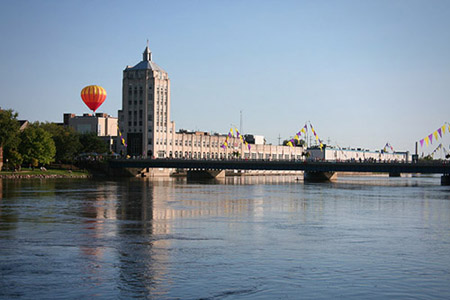Rockford area is #4—should we celebrate with a pizza.
According to a recent poll by Gallup, 26 percent of American adults are obese. The obesity epidemic has been going on for decades, and today health-care costs associated with obesity are estimated at $147 billion a year.
To be considered obese, a person has a body mass index (BMI) of 30 or higher. With the extra weight comes myriad health issues — obesity contributes to heart disease, diabetes, stroke, and some cancers.
See slideshow: America's Fattest Cities
Recently, the Gallup-Healthways Well-Being Index ranked the most obese metropolitan areas in the U.S., offering perspective on the cities that are affected by the country’s obesity woes.
The health implications are apparent — of the 10 metro areas with the highest obesity levels, 58 percent of their residents were more likely to report having had a heart attack over the course of their lifetimes, and 34 percent were more likely to report having high blood pressure. Combined, residents of these cities also pay an estimated $1 billion more in medical costs each year thanks to their high obesity rates.
In 2010, the government announced its goal to lower the prevalence of obesity to 15 percent. In 2011, only three out of the 190 areas surveyed in the Gallup-Healthways Well-Being Index had an obesity rate below that level: Fort-Collins-Loveland, Colo.; Bridgeport-Stamford-Norwalk, Conn.; and Boulder, Colo. Boulder ranked as the least obese city, with an obesity rate of 12.1 percent.
Read on to see the five most obese metro areas in the U.S., and how much their citizens are paying in obesity-related health-care costs every year, according to the recent Gallup survey.
5. Beaumont-Port Arthur, Texas
Obesity rate: 33.8 percent
Annual obesity-related costs: $182.8 million
Beaumont-Port Arthur is one of two Texas regions in the top five.
Photo: accent on eclectic / FlickrOil is big business for this region in southeast Texas, with refineries throughout the area. The metro area has been a major player in the oil industry ever since the Lucas Gusher exploded on Spindletop Hill in 1901.
According to the Gallup-Healthways Well-Being Index, the metro area could potentially save $101.6 million in medical costs if its obesity rate dropped to 15 percent, instead of the almost 34 percent it has now. Beaumont-Port Arthur is the second-most obese metro area in Texas, which has a statewide obesity rate of 31 percent.
4. Rockford, Illinois
Obesity rate: 35.5 percent
Annual obesity-related costs: $179.4 million
The "City of Gardens" has nearly 54,000 obese residents.
Photo: Ben Jacobson / Wikimedia CommonsLocated in northern Illinois, Rockford calls itself the “City of Gardens” because of the 7,000 acres of parks, trails, tree-lined streets, and public gardens within its borders. That’s not the only nickname the city has had — it has also been called “Forest City” because of its woods and was once known as the “Screw Capital of the World” because of factories that produced screws and bolts. Manufacturing is still the area’s biggest industry.
Rockford also ranks as the fourth-fattest city in the country, however, with an obesity rate of 35.5 percent. Of the more than 152,000 people who live in Rockford, nearly 54,000 are considered obese, while 10 percent have diabetes and 23 percent live below the poverty line.
3. Huntington-Ashland, West Virginia-Kentucky-Ohio
Obesity rate: 36 percent
Annual obesity-related costs: $146.9 million
The region was once called the nation's least healthy .
Photo: Wikimedia CommonsThe Huntington-Ashland metropolitan area encompasses three states — West Virginia, Kentucky and Ohio — at the point where they all meet by the Ohio River.
The metro area first gained national attention in 2008 after an Associated Press story called it the nation’s unhealthiest. That led Jami Oliver to bring his ABC reality show, “Jamie Oliver’s Food Revolution” into Huntington, W.Va., to give schools and the town a nutrition make-over. Oliver has called his time there a success. However, the larger metro area still appears to be struggling — 36 percent of its citizens are obese, according to the Gallup-Healthways Well-Being Index, and nearly 20 percent suffer from diabetes.
2. Binghamton, New York
Obesity rate: 37.6 percent
Annual obesity-related costs: $131.5 million
Binghamton's obesity rate sharply contrasts with New York state's.
Photo: Getty ImagesIn the city of Binghamton, more than 17,000 residents are obese, according to rates from the Gallup-Healthways Well-Being Index. It's surprising then that 54 percent of respondents also said they exercise frequently.
Located at the junction of the Susquehanna and Chenango rivers in southern New York, Binghamton has the highest obesity rate in the state, compared with New York State’s rate of just below 24 percent. Meanwhile, 27.8 percent of Binghamton’s population lives below the poverty level.
1. McAllen-Edinburg-Mission, Texas
Obesity rate: 38.8 percent
Annual obesity-related costs: $410.9 million
The fattest area's obesity rate went up 5.5 percent last year.
Photo: bankruptcyattorney / FlickrLocated near the Mexican border in southern Texas, this metro area is the most obese in the nation, according to the Gallup-Healthways Well-Being Index. If the region dropped the rate from 38.8 percent to 15 percent, it could potentially save a whopping $252 million a year in medical costs annually. That’s a big savings, especially considering 50 percent of residents report being uninsured.
In 2010, 33.3 percent of the McAllen-Edinburg-Mission metropolitan area’s population was obese, according to a CDC survey, so the data suggest that the country’s most obese city is also getting worse, bucking the nationwide trend of stabilization in obesity rates






No comments:
Post a Comment